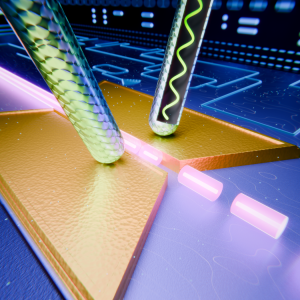Knowledge Center
Welcome to the Polariton Knowledge Center, your go-to hub for the latest in plasmonics, photonic integrated circuits (PICs), and ultra-fast electro-optic modulation.
Whereas you’re diving into the fundamentals or exploring advanced applications, this centralized directory informs you about related papers and information about the plasmonic and photonics information from Polariton.
On Giant’s Shoulders
Specifically, you will find here a curated repository of technical knowledge, designed to support engineers, researchers, product developers, and students working with high-speed optical communication systems.
Regardless if terahertz (THz) bandwidth modulators to cryogenic photonics for quantum computing. Moreover, it showcases innovations shaping the future of photonic technologies in our own Polariton style.
Nonetheless, we believe that access to well-structured, credible knowledge accelerates innovation, this is why you will find:
— Peer-reviewed publications showcasing research in plasmonic PICs
— Tutorials
— Frequently asked questions (FAQ)
— In-depth articles exploring use cases from quantum communication to data centers
Applications Covered
In essence, this content is tailored to multiple application areas, including:
— High-speed fiber-optic communication
— Sub-terahertz wireless transmission
— Photonic links in cryogenic environments
— Integration of plasmonics with silicon photonics
— Quantum photonics and on-chip signal processing
— Featured Topics and Publications
Lastly, we believe in collaboration across industry and academia. That’s why we refer to seminal works from ETH Zurich, Optica, IEEE, ACS Photonics, and more. You’ll find papers co-authored by leaders in the field, such as Prof. Juerg Leuthold, Claudia Hoessbacher, and Wolfgang Heni.
L. Kulmer, et al. O-Band Plasmonic MZM enabling Single Carrier net 400 Gbit/sIM/DD over 1 km Fiber (ECOC, 2025)
How much of the fiber-to-fiber losses comes from the plasmonic propagation losses?
The plasmonic propagation losses make up slightly more than half of the total losses.
What technology enables your improved performance?
Our modulators are based on the plasmonic-organic-hybrid (POH) platform. This combines plasmonic wave guiding with organic second-order nonlinear optical (NLO) materials. In plasmonics, light is guided as a surface plasmon polariton (SPP) at metal-insulator interfaces. This enables light confinement well below the diffraction limit, which results in an enhanced light-matter interaction.
What advantage is your product offering compared to established technologies?
The POH platform combines advantages from organic NLO materials and plasmonic slot waveguides. This means, our modulators offer linear phase modulation, ultrafast speed, high nonlinearities, subdiffraction confinement of light, enhanced light-matter interaction leading to voltage-length products one order of magnitude smaller than photonics, small RC time constants, and reduced plasmonic losses.
Where are your modulators fabricated?
Our modulators are designed, fabricated, assembled and tested in Switzerland.
Do you offer accompanying services?
